 | ||
San francisco pride parade 2016 trikone lesbian gay bisexual transgender south asians
The San Francisco Lesbian, Gay, Bisexual, and Transgender Pride Celebration, usually known as San Francisco Pride, is a parade and festival held at the end of June each year in San Francisco, California, to celebrate the lesbian, gay, bisexual, and transgender (LGBT) people and their allies. The 44th annual parade in 2014 included over 200 parade contingents, and is described on the official website as "the largest gathering of LGBT people and allies in the nation".
Contents
- San francisco pride parade 2016 trikone lesbian gay bisexual transgender south asians
- San francisco pride parade 2013 trikone lesbian gay bisexual transgender south asians
- Parade
- Contingents
- Festival
- Administration
- History
- 2013 Private Manning controversy
- References

San francisco pride parade 2013 trikone lesbian gay bisexual transgender south asians
Parade
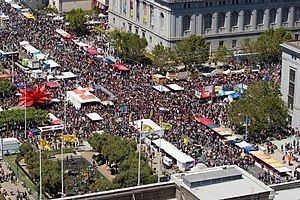
The San Francisco Pride parade is a world-renowned LGBT pride parade. It is held on Sunday morning of the Festival. The route is usually west along San Francisco's Market Street, from Steuart Street to 8th Street and it runs from 10:30 am until almost 3:00 pm. Participants line up off the parade route in advance of the start of the parade.
Contingents
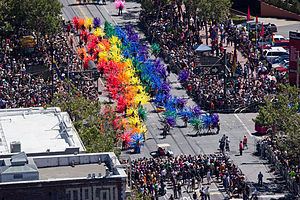
The parade consists of hundreds of contingents from various groups and organizations. Some of the more well-known contingents are:
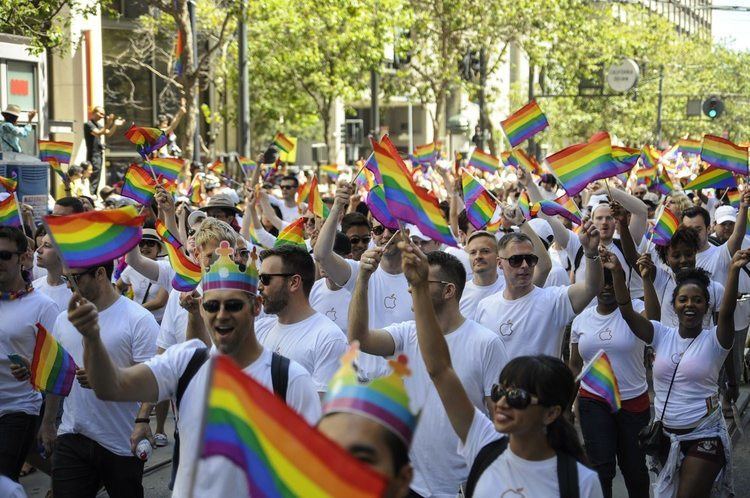
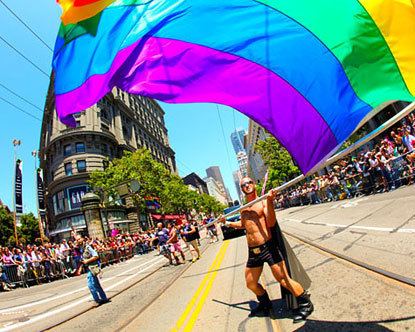
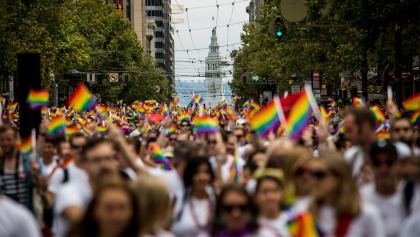
Groups which are anti-gay typically do not have contingents. During the 1990s it was common to see anti-gay protestors in the spectator area along the parade route, holding large signs condemning homosexuality, often with biblical passages. In the 2000s such protestors have become less common.
Hundreds of thousands of spectators line the parade route along Market Street. Some arrive hours in advance to claim a prime spot on the curb with a clear view of the street. Others climb onto bus shelters, the walls of subway station stairs, or scaffolding on buildings to get a clear view. As the parade ends, the spectators are able to pass through the barriers and march down Market street behind the parade. The end of the parade route is near the Festival location at the Civic Center.
Festival
A two-day (Saturday and Sunday) festival has grown up around the Sunday morning parade. It is a collection of booths, dance stages, and vendors around the Civic Center area near San Francisco City Hall. On the Sunday of the parade, an area of the festival called Leather Alley features fetish and BDSM oriented booths and demonstrations.
The festival is traditionally held in the last full weekend in June. This commemorates the Stonewall riots. There have been proposals to move it to different dates, for instance to July 4 in 2004.
The independently organized Trans March is held on the Friday before the parade while the Dyke March and Pink Saturday events are held the Saturday night of the festival in The Castro.
Administration
The festival is run by a non-profit organization, the San Francisco Lesbian, Gay, Bisexual, Transgender Pride Celebration Committee. According to their web site, their mission is "to educate the World, commemorate our heritage, celebrate our culture, and liberate our people."
The event is funded by a combination of community fundraising both by the pride committee and on their behalf, corporate sponsorships, San Francisco city grants, and donations collected from the participants at the festival.
Several veteran contractors are employed to take on specific roles for the event.
Also involved in the running of the festival and parade are hundreds of volunteers. Of particular note are:
History
The first event resembling the modern San Francisco Pride parade and celebration was held in 1970—with a march down Polk Street and a small "gay-in" in Golden Gate Park. Since 1972, the event has been held each year. The name of the festival has changed over the years. The event organizers each year select a theme for the event, which is reflected in the logo and the event’s publicity.
The Rainbow Flag identified with the LGBT community was originally created by Gilbert Baker for the 1978 San Francisco Pride Parade. It originally had eight stripes, but was later simplified to the current six stripes. A six-stripe Rainbow Flag flies over Harvey Milk Plaza in the Castro, arguably the best known LGBT village in the world.
On August 3, 1997, Teddy Witherington (who previously organized the London LGBT Pride Event 1991–1997, including the first EuroPride Festival in 1992) was hired as the organization's first Executive Director. During his tenure, the celebration evolved into a multi-cultural festival and attracted support from high-profile celebrities and sponsors, including the B52s as Main Stage headliners in 2001 and Sir Ian McKellen as Grand Marshal in 2002. Witherington formally stepped down on January 6, 2006 and was succeeded by Lindsey Jones who had joined the staff in 2004. Jones served as executive director through the 2009 event.
In October 2009, LGBT activist Amy Andre was appointed as executive director of the San Francisco Pride Celebration Committee, making her San Francisco Pride's first openly bisexual woman of color executive director.
Also in 2009, Asexual Visibility and Education Network members participated in the first asexual entry into an American pride parade when they walked in the San Francisco Pride Parade. They have entered subsequent parades since.
Andre resigned a year later in October 2010 and was succeeded by former deputy executive director, Brendan Behan. Behan served as Executive Director April 2011 through December 2012 when Earl Plante was hired as CEO. Plante resigned September 6, 2013.
George Ridgely was hired to the position of Executive Director January 7, 2014 and currently serves in that position.
In May 2015, Kent Anderson was hired as Deputy Executive Director.
Currently serving on San Francisco Pride's 13-person governance Board of Directors: Michelle Meow (President), Melanie Nathan (Vice President), Jacquelene Graziano Bishop (Treasurer), William Walker (Secretary), Kenzi Connor, Anietie Ekanem, Jason Galisatus, DJ Gray, Nguyen "Win" Pham, Joey "Cupcake" Stevenson, and Justin Taylor; two seats are vacant.
Note: Several facts in this section are taken from KQED’s LGBT timeline. Logos of the various festivals may be seen at SF Pride’s website.
2013 Private Manning controversy
On April 24, 2013, Pride announced that its electoral college had chosen U.S. Army Private First Class Chelsea (then known as Bradley) Manning as Community Grand Marshal in absentia for the 43rd annual Gay Pride Parade. Two days later, Pride's board president vetoed the election, declaring it "an error" due to a "systemic failure that now has become apparent and will be rectified." The board subsequently explained that the category in which Manning was elected is restricted to "a local hero (individual) not being a celebrity"—neither of which befit Manning.
Both the election and its nullification proved contentious. On April 29, an estimated 200 protesters disrupted the board's meeting, demanding that PFC Manning be reinstated. On May 7, 21 individual Manning supporters and 5 organizational signatories filed a formal Complaint of Unlawful Discrimination with the San Francisco Human Rights Commission, noting that SF Pride received $58,400 from the City and County of San Francisco's Grants for the Arts Program in fiscal year 2012–2013. On May 12, the board said it would meet "in a larger venue after the 2013 Celebration and Parade [to] allow people from all sides of that issue and others to fully air and hear one another's viewpoints, without jeopardizing the production of this year's event and the safety and security of the attendees." Standing firm by its decision, the board said it would not "let one issue, as important as it is to some, overshadow the concerns and interests of the hundreds of thousands who attend SF Pride." On June 7, 2013, the board announced that since none of the alternatives submitted at a May 31 community forum garnered a consensus majority, the board's decision to rescind PFC Manning's grand marshalship would stand. The board also reported that the San Francisco Human Rights Commission had declined to investigate the discrimination claims filed against SF Pride.
